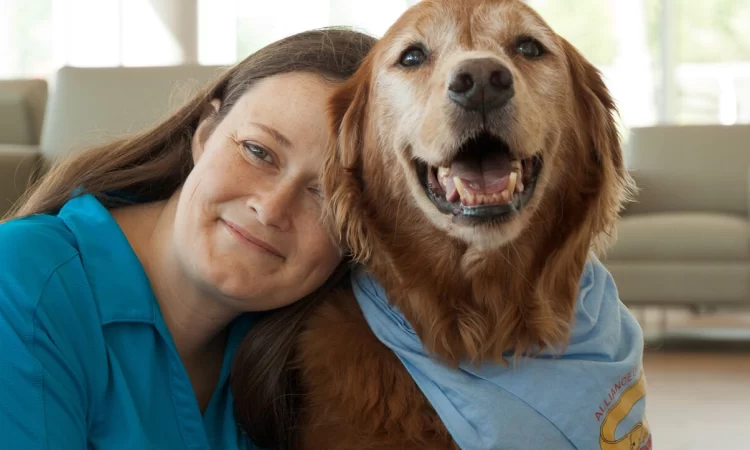
Therapy dogs are well-known for their work in hospitals and care homes, but their presence is increasingly felt in less traditional settings. From courts to disaster zones, and even in artistic environments, therapy dogs are providing comfort and support in various unconventional situations.
This article explores the impactful stories of therapy dogs working in these unique environments and their profound impact on human well-being.
Therapy Dogs in Courtrooms
In courtrooms, therapy dogs serve a unique and compassionate role. They provide emotional support to witnesses, particularly children, who may find the experience of testifying traumatic.
For example, a courthouse in Washington, D.C., has a program where trained therapy dogs accompany young witnesses to the stand, helping to alleviate their anxiety and stress. This presence can be a calming influence, enabling witnesses to deliver their testimonies more effectively.
Disaster Zones: Canine Comfort in Crisis
In disaster zones, therapy dogs have become invaluable in supporting both victims and first responders. After events like earthquakes, hurricanes, or shootings, therapy dogs are brought in to provide comfort to those affected.
One notable example is the deployment of therapy dogs to Parkland, Florida, following the tragic school shooting in 2018. These dogs offered a source of unconditional love and comfort during a time of immense grief and shock.
Therapy Dogs in Schools and Universities
In educational settings, therapy dogs are increasingly common. They are used to help students cope with stress, anxiety, and the pressures of academic life. Universities across the globe are introducing therapy dog programs, especially during exam periods, to help students relax and de-stress.
A study from the University of British Columbia found that interaction with therapy dogs significantly reduced students’ stress levels.
Canine Assistance in Artistic Settings
Therapy dogs are also finding a place in artistic settings, such as music studios, art therapy sessions, and theaters. Their presence can stimulate creativity and provide emotional support to artists and performers.
In New York City, a theater company introduced a therapy dog to its cast and crew, helping to reduce anxiety and build a sense of community among the team which is essential for puppies and their owners to have a harmonious relationship.
Therapy Dogs in Rehabilitation Centers
In rehabilitation centers, therapy dogs assist individuals recovering from injuries, addictions, or mental health issues. Their presence can accelerate the healing process by providing emotional support, encouraging interaction, and creating a nurturing environment.
For instance, a rehabilitation center in Colorado uses therapy dogs to assist in the treatment of patients with traumatic brain injuries, significantly improving patient morale and motivation.
Support for Veterans with PTSD
Therapy dogs play a critical role in supporting military veterans suffering from PTSD. These dogs are trained to recognize signs of anxiety and PTSD episodes, providing immediate comfort and a sense of safety to their owners. The impact of these dogs on veterans’ lives can be life-changing, offering a source of stability in their journey towards recovery.
Therapy Dogs in Nursing Homes
While not entirely unconventional, therapy dogs in nursing homes deserve a special mention for their profound impact on the elderly. These dogs provide companionship, reduce feelings of isolation, and can even help in the recovery of motor skills through petting and walking activities.
The Impact of Therapy Dogs on Mental Health
The presence of therapy dogs has shown a significant positive impact on mental health. Interactions with therapy dogs have been proven to lower stress hormones, reduce blood pressure, and increase levels of endorphins and oxytocin.
In all the settings mentioned, these physiological changes translate into real emotional and psychological benefits for those interacting with the dogs.
Training and Selection of Therapy Dogs
The dogs selected for these roles undergo extensive training to ensure they are well-suited for the environment and the people they will be assisting. This training includes socialization, obedience, and specific scenarios they might encounter in their unique working environments. The key qualities sought in therapy dogs are a calm demeanor, friendliness, and a gentle nature.
Challenges and Considerations
While the benefits are immense, there are challenges and considerations in integrating therapy dogs into unconventional settings. These include ensuring the well-being of the dogs, managing allergies or fears among people they interact with, and maintaining a high standard of training and certification.
The Future of Therapy Dogs in Unconventional Settings
As awareness of the benefits of therapy dogs grows, so does their presence in various unconventional settings. The future may see an even broader range of environments where these dogs can contribute, from corporate offices to spaces of political or social unrest.
Conclusion
Therapy dogs are more than just pets; they are a source of comfort, healing, and emotional support in a wide array of environments. From providing solace in disaster zones to inspiring creativity in artistic settings, these dogs have a significant impact on human well-being.
As society continues to recognize the value of animal-assisted therapy, the role of therapy dogs in unconventional settings will likely expand, continuing to touch lives in profound and meaningful ways.




